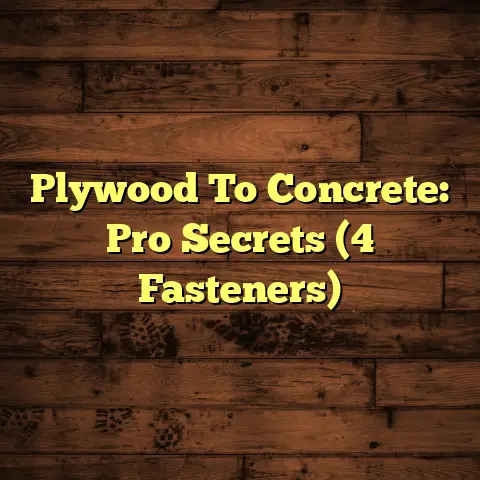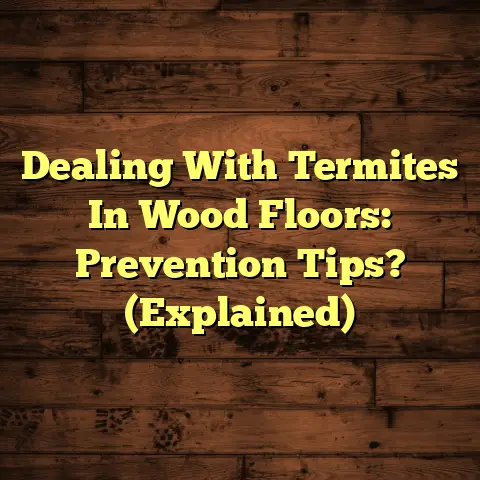Clean Polyurethane Wood Floors? (3 Mistakes To Avoid!)
Think back. Remember that house?
Maybe it was Grandma’s, or your childhood home.
I bet I know what you remember: those gleaming
wood floors.
Sunlight streaming through the windows,
dust motes dancing in the golden light.
The soft thump of footsteps, the echo of laughter…
Family gatherings, cozy nights by the fire, all played out on those beautiful floors.
Wood floors just feel like home, don’t they?
And if you’re lucky enough to have polyurethane finished wood floors, you know the pride that comes with keeping them looking their best.
Maintaining those floors is what we’re going to talk about today.
Understanding Polyurethane Wood Floors
Okay, so what are polyurethane wood floors, exactly?
Basically, it’s wood flooring that has been coated
with a polyurethane finish.
Polyurethane is a
synthetic resin that dries to form a tough, durable,
and protective layer.
Think of it as a shield for your wood!
The benefits are huge: durability (they can handle a lot of foot traffic), resistance to moisture (a lifesaver in kitchens and entryways), and, importantly for our chat today, they are relatively easy to clean.
Now, there are two main types of polyurethane finishes: oil-based and water-based.
Oil-based polyurethane is known for its rich amber color and its ability to deepen the natural tones of the wood.
It’s super durable, but it takes longer to dry and has a stronger odor during application.
I’ve used it on projects where the client wanted that classic, warm look.Water-based polyurethane, on the other hand, is clear and doesn’t yellow over time.
It dries much faster than oil-based, has a lower odor, and is generally considered more environmentally friendly.
It’s a great option if you want to maintain the wood’s natural color.
Polyurethane finishes really took off in the
mid-20th century.
Before that, wood floors were
often finished with wax or varnish, which required
a lot more upkeep.
Polyurethane revolutionized
wood floor care by providing a tough, long-lasting,
and easy-to-clean surface.
Think about it: less elbow grease, more time to enjoy your beautiful floors!
The Importance of Proper Cleaning Techniques
Let’s be real: you want your floors to look amazing,
right?
Proper cleaning isn’t just about aesthetics.
It’s about protecting your investment and ensuring your floors last for years to come.
Routine cleaning is crucial for removing dirt, dust, and grime that can scratch and dull the polyurethane finish.
Think of those tiny particles as sandpaper, slowly wearing away at the protective layer.
Regular cleaning prevents buildup, maintains the shine, and keeps your floors looking their best.
But here’s the catch: not all cleaning methods are created equal.
Homeowners often make mistakes that can actually damage their polyurethane wood floors.
I’ve seen it all, from using harsh chemicals to over-wetting the floors.
And that’s what we’re going to focus on today.
Let’s dive into the three biggest mistakes I see homeowners make when cleaning their polyurethane wood floors, and how to avoid them.
Mistake #1: Using the Wrong Cleaning Products
This is a big one.
What you use to clean your floors
matters a lot.
Using the wrong cleaning product can strip the polyurethane finish, dull the shine, or even cause permanent damage.
So, what should you avoid?
Ammonia-based cleaners are a definite no-no.
Ammonia is a harsh chemical that can break down the polyurethane finish, leaving your floors looking dull and lifeless.
Vinegar, while often touted as a natural cleaner, is also problematic.
The acidity in vinegar can damage the finish over time.
Think of it as slowly etching away at the protective layer.
Abrasive materials, like scouring pads or steel wool, are another big mistake.
These will scratch the polyurethane finish, leaving behind unsightly marks.
So, what should you use?
The best option is a pH-balanced, wood-safe cleaner specifically designed for polyurethane finishes.
These cleaners are formulated to gently remove dirt and grime without damaging the protective layer.
Look for products that are labeled as “safe for polyurethane floors” or “wood floor cleaner.”
I often recommend Bona Hardwood Floor Cleaner.
It’s pH-neutral and specifically designed for
polyurethane finishes.
Another great option is Murphy Oil Soap, but be sure to dilute it properly according to the manufacturer’s instructions.
DIY Cleaning Solutions
If you prefer a DIY approach, here’s a simple and safe cleaning solution you can make at home:
- Mix 1/4 cup of mild dish soap (like Dawn) with 1 gallon of warm water.
- Make sure the dish soap is pH neutral.
- Damp mop the floors with the solution, being careful not to over-wet them.
- Rinse with clean water and dry thoroughly.
Remember, always test any cleaning product or solution in an inconspicuous area first to make sure it doesn’t damage the finish.
I always tell my clients: when in doubt, less is more.
It’s better to use a gentle cleaner and a little
elbow grease than to risk damaging your floors
with a harsh chemical.
Mistake #2: Over-Wetting the Floors
Water and wood don’t mix!
Well, they can, but not in large quantities.
Excessive water can seep into the seams of the wood flooring, causing it to warp, swell, and even rot.
It can also damage the polyurethane finish, leading to discoloration and peeling.
I’ve seen floors buckle and warp from over-wetting, and it’s not a pretty sight.
The key is to damp mop, not wet mop.
What’s the difference?
Damp mopping means using a mop that is only slightly damp, not soaking wet.
You should be able to wring out the mop and not have any water dripping from it.
Here’s how to damp mop correctly:
-
Use a microfiber mop: Microfiber mops are excellent at picking up dirt and grime without using excessive water.
-
Wring out the mop thoroughly: Before mopping, wring out the mop head until it’s barely damp.
-
Mop in the direction of the wood grain: This helps to prevent streaks and ensures that you’re effectively cleaning the surface.
Work in small sections: Don’t try to mop the entire floor at once.
Work in small sections, rinsing and wringing out the mop as needed.Dry the floors immediately: After mopping, dry the floors with a clean, dry towel or microfiber cloth.
This will help to prevent water from seeping into the seams.
Spray Bottle Magic
Another great way to clean without over-wetting is to use a spray bottle.
Fill a spray bottle with your chosen cleaning solution and lightly mist the floor.
Then, wipe the floor with a clean, dry microfiber cloth.
This method allows you to target specific areas and avoid saturating the floors with water.
I often use this method for spot cleaning spills or
stains.
It’s quick, easy, and effective.
Remember, the goal is to clean the surface without allowing water to penetrate the wood.
A little caution goes a long way in protecting your floors from water damage.
Mistake #3: Neglecting Regular Maintenance
Think of your wood floors like a car.
You wouldn’t
drive it for years without changing the oil, right?
The same goes for your floors.
Neglecting regular maintenance can lead to a buildup of dirt, grime, and scratches, which can dull the polyurethane finish and shorten the lifespan of your floors.
What does regular maintenance look like?
It starts with daily sweeping or vacuuming.
This is essential for removing dirt and debris that can scratch the finish.
Use a soft-bristled broom or a vacuum with a hardwood floor attachment.
Avoid using vacuums with beater bars, as these can scratch the finish.
Weekly damp mopping is also important for removing dirt and grime that sweeping or vacuuming misses.
Use a pH-balanced, wood-safe cleaner and a damp microfiber mop, as we discussed earlier.
Periodic professional cleaning and refinishing are also necessary to keep your floors looking their best.
Professional cleaning can remove stubborn stains and buildup that regular cleaning can’t tackle.
Refinishing involves sanding down the old polyurethane finish and applying a new coat.
This can restore the shine and protect the wood from further damage.
Maintenance Schedule
Here’s a maintenance schedule you can follow to keep your polyurethane wood floors in top condition:
- Daily: Sweep or vacuum to remove dirt and debris.
- Weekly: Damp mop with a pH-balanced, wood-safe cleaner.
- Monthly: Inspect your floors for scratches, stains, or other damage.
- Every 3-5 years: Have your floors professionally
cleaned and consider refinishing if necessary.
- Note: This timeframe depends on foot traffic and wear.
I know it sounds like a lot, but trust me, a little maintenance goes a long way.
By following a regular cleaning and maintenance schedule, you can keep your polyurethane wood floors looking beautiful for years to come.
Conclusion: Cherishing the Beauty of Your Home
Remember those warm, inviting homes from our
childhood?
The ones with the gleaming wood floors?
Those floors weren’t just surfaces; they were the backdrop to countless memories.
They witnessed family gatherings, laughter, and cozy evenings by the fire.
They were a part of the fabric of our lives.
And that’s why it’s so important to take care of our wood floors.
By avoiding the common mistakes we’ve discussed today – using the wrong cleaning products, over-wetting the floors, and neglecting regular maintenance – you can preserve the beauty of your floors for years to come.
Think of it as an investment in your home and in the memories you’ll create within its walls.
Your home is more than just a building; it’s a reflection of who you are and the people you love.
And well-maintained wood floors play a vital role in creating a warm, inviting, and cherished atmosphere.
So, go forth and care for your floors with love and attention.
Your home will thank you for it!





